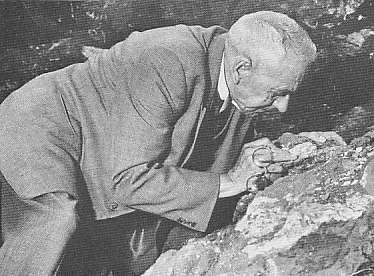Copyright © Jim Foley || Email me

 Robert Broom was born in Scotland in 1866 to a poor family. Educated as a
doctor specializing in midwifery, he used that profession to support
himself while travelling the world. Fascinated by the origin of the
mammals, he travelled to Australia in 1892. Five years later, he went to
South Africa, where he would stay for the rest of his life.
Robert Broom was born in Scotland in 1866 to a poor family. Educated as a
doctor specializing in midwifery, he used that profession to support
himself while travelling the world. Fascinated by the origin of the
mammals, he travelled to Australia in 1892. Five years later, he went to
South Africa, where he would stay for the rest of his life.
In 1910 Broom's insistence on the theory of evolution cost him his position at the University of Stellenbosch, an extremely conservative religious institution, and he started practicing medicine in the remote Karroo region of South Africa. He also practised paleontology, becoming the world's leading expert on the mammal-like reptiles which were found in abundance in the region. His paleontological work was so highly regarded that in 1920 he was made a Fellow of the Royal Society.
In 1934, aged 68, he gave up his medical practice to take a position at the Transvaal Museum in Pretoria. In 1936 he decided to search for more of Dart's australopithecines, and in the same year found a fragmentary skull of an adult at Sterkfontein (which he initially placed in a new genus, Plesianthropus). In 1938, he found the first robust australopithecine skull at Kromdraai after a schoolboy discovered some teeth at the site. Further finds followed, but it was not until Broom published a major monograph on the australopithecines in 1946 and the influential British scientist W. E. Le Gros Clark examined the fossils in 1947 that most scientists finally accepted that the australopithecines were hominids. Other major finds included Sts 5, a superb fossil skull, and Sts 14, a partial skeleton which consisted of much of a pelvis, femur, and vertebral column and proved convincingly that australopithecines had walked upright.
In 1948 he started excavating at Swartkrans, which yielded remains of what was later determined to be Homo erectus, as well as further australopithecine fossils.
Somewhat of an eccentric, Broom, conscious of his standing as a medical man, always dressed in a formal dark suit even when fossil hunting, but would strip naked when it got too hot. He remained prodigiously energetic until the end of his life. Broom had promised that he would "wear out, not rust out", and was true to his word. In 1951, after writing the finishing lines of his monograph on the australopithecines, he whispered "Now that's finished ... and so am I". He died moments later at the age of 85.
Wills C. (1993): The runaway brain: the evolution of human uniqueness. New York: Basic Books.
Robert Broom (1950): Finding the Missing Link. London: Watts & Co.
This page is part of the Fossil Hominids FAQ at the talk.origins Archive.
Home Page |
Species |
Fossils |
Creationism |
Reading |
References
Illustrations |
What's New |
Feedback |
Search |
Links |
Fiction
http://www.talkorigins.org/faqs/homs/rbroom.html, 04/24/98
Copyright © Jim Foley
|| Email me 